Saturday, September 03, 2005
Billon antoninianus, Saloninus, Samosata, Göbl 1707e
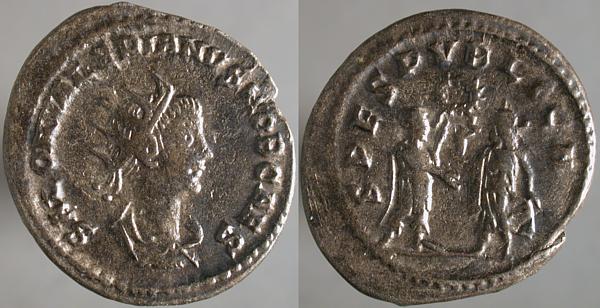
SALON VALERIANVS NOB CAES, Radiate draped cuirassed bust right | SPES PVBLICA, Spes standing left, presenting flower to Saloninus. Wreath above.
Saloninus was the younger son of Gallienus, and was made Caesar after the death of his brother Valerian II, this was no portent of better things. Ambition on the part of the general Postumus is blamed for the death of Saloninus and for Postumus then rebelling and declaring himself Emperor of an empire somewhat reduced in size.
Friday, September 02, 2005
Æ31, Seleucia ad Calycadnum in Cilicia, Gallienus, SNG v Aul 5853
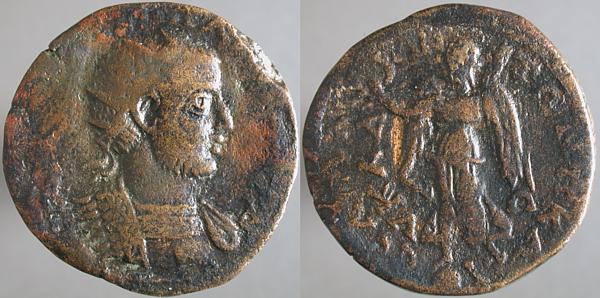
AV K ΠO ΛIKIN ΓAΛΛIHNON, Radiate cuirassed bust right | CEΛEVKEΩN TΩN ΠPOC KAΛAΔNO, Nike on standing facing on globe, head left, holding wreath left and palm branch right.
Modern Silifke, built on the ruins of Seleucia ad Calycadnum. I'm particularly taken with the last photo: "a bridge built on the old Roman bridge". I wouldn't want to live in the Roman empire, but I do admire them for some things. Constructing bridges and aquaducts and roads certainly were areas that they'd mastered.
Thursday, September 01, 2005
Billon antoninianus, Valerian, Samosata, Göbl 1688e
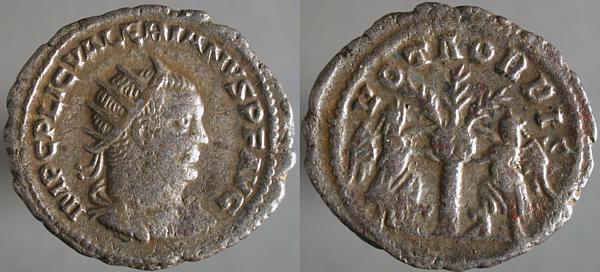
IMP C P LIC VALERIANVS P F AVG, Radiate draped cuirassed bust right | VOTA ORBIS, Two victories fixing shield inscribed SC to palm tree.
Here, here, and here I've posted coins with this same reverse, but with different obverses. This leaves me, I admit, with even less to say than usual.
Here's an interesting treatment of how the representation of Nike/Victoria becomes the familiar image of an angel.
Wednesday, August 31, 2005
Silvered Æ antoninianus, Quintillus, 270 CE, Rome, RIC 18
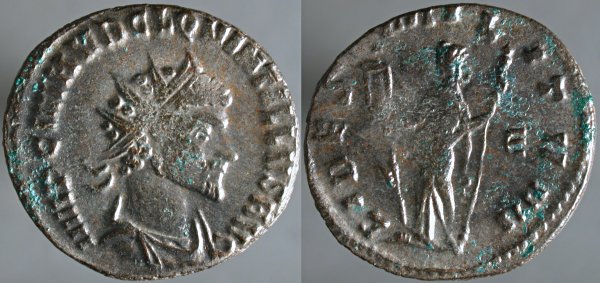
IMP C M AVR CL QUINTILLUS AVG, Radiate draped cuirassed bust right | FIDES MILITVM, Fides standing facing, head left, holding scepter right and vexillum left. E in left field.
Marcus Aurelius Claudius Quintillus was the brother of Claudius II Gothicus and assumed the office on the death of Claudius.
Soon enough he was dead, unremarked for any great achievements or failures. There is no concensus on whether that was a matter of days, week, or months, no consensus on the date had died. His coins aren't especially rare or expensive, so I think it was months.
As that may be, he did both become emperor and then die within the year 270.
Tuesday, August 30, 2005
Æ30, Side in Pamphylia, Salonina, SNG Copenhagen 429, ...
Sear GIC 4676, BMC 123
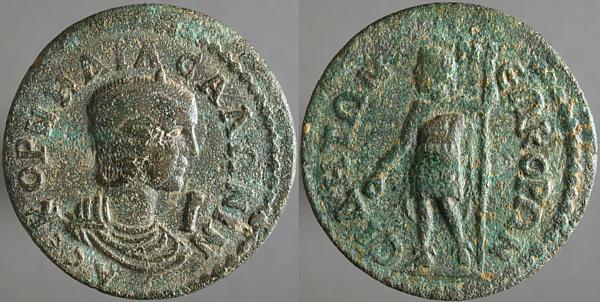
KOPNHΛIA CAΛΩNINA CE, Diademed draped bust right, I before | CIΔHTΩN N_EΩKOPΩN, Apollo Sidetes standing facing, head left, holding patera left and scepter right.
At this writing, every Google hit for "Apollo Sidetes" is a citation of a coin said to feature him, so I know nothing about this aspect of Apollo. I understand Sidetes here to mean "of Side", but that's not really very illuminating.
This page dates Side back to the late seventh century BCE, with an older Anatolian settlement giving the site its name. Perhaps Apollo Sidetes was a local god from the time of that Anatolian settlement who was rationalized as Apollo.
Or not.

KOPNHΛIA CAΛΩNINA CE, Diademed draped bust right, I before | CIΔHTΩN N_EΩKOPΩN, Apollo Sidetes standing facing, head left, holding patera left and scepter right.
At this writing, every Google hit for "Apollo Sidetes" is a citation of a coin said to feature him, so I know nothing about this aspect of Apollo. I understand Sidetes here to mean "of Side", but that's not really very illuminating.
This page dates Side back to the late seventh century BCE, with an older Anatolian settlement giving the site its name. Perhaps Apollo Sidetes was a local god from the time of that Anatolian settlement who was rationalized as Apollo.
Or not.
Monday, August 29, 2005
Billon antoninianus, Gallienus, Siscia, Göbl 1513b
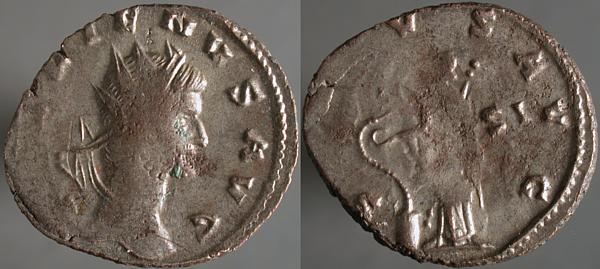
GALLIENVS AVG, Radiate head right | SALVS AVG, Salus standing facing, head left, feeding snake rising from cippa left, holding transverse scepter. SI in right field.
In striking a coin, both dies compress the blank, the high points on the dies yielding the lowest points on the coin, and the most deeply engraved parts of the die compress the blank the least, leaving the highest points on the coin.
If the deepest part of each die are placed just opposite that of the other die, if the blank is a bit thin (or if an already-compressed coin is used instead of a blank,) if the dies are struck with insufficient force, then the image may not transfer properly and, as in this case, areas that are meant to be raised up from the field may instead be quite flat, as the reverse of this coin is.
Sunday, August 28, 2005
Æ30, Aspendos in Pamphylia, Salonina, SNG France 3
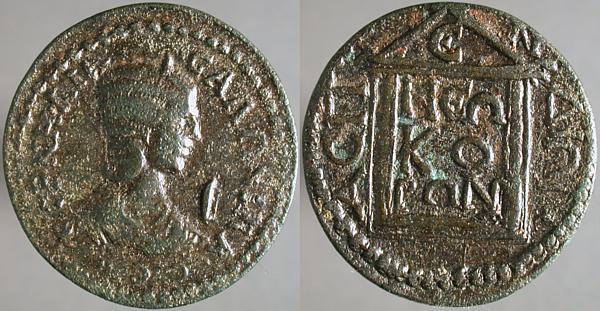
KOPNHΛIA CAΛΩNINA CEB, Diademed draped bust right, I before | ACΠ_E_N_ΔIΩN, Stele inscribed NEΩ / KO / PΩN.
A useful page on The Imperial Cult & Neokorate.

